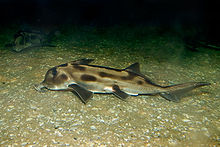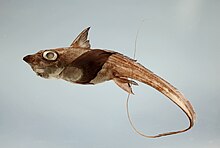Sea cats
| Sea cats | ||||||||||||
|---|---|---|---|---|---|---|---|---|---|---|---|---|

Spotted sea rat ( Hydrolagus colliei ) |
||||||||||||
| Systematics | ||||||||||||
|
||||||||||||
| Scientific name | ||||||||||||
| Chimaeriformes | ||||||||||||
| Obruchev , 1953 |
The sea cats (Chimaeriformes), also chimeras ("hybrid creatures", cf. Chimera ), spooks , sea dragons , sea rats or ghost sharks , are the third major taxon of cartilaginous fish ( Chondrichthyes ) alongside sharks and rays . They are little-known marine fish that mainly populate the continental slopes . Chimaeras are the only extant representative of the subclass Holocephali . A total of about 55 species are distinguished, which are assigned to three families.
distribution and habitat
Sea cats live in all oceans, from the Arctic Ocean to the tropics to the sub-Antarctic . They occur mainly at depths of 200 to 2000 meters, up to a maximum of 3000 meters. In the tropical seas, the chimeras are species-poor, the few species living there are mainly in the deep sea. Plownose chimeras only occur in the southern hemisphere at shallower depths of ten to about 375 meters. The habitat of the sea cats is mainly the continental slopes and the ocean floors. None live pelagically in the open ocean, but some are close to archipelagos, e.g. B. in Hawaii .
features

Sea cats are outwardly similar to the grenadier fish (Macrouridae) and the deep-sea tadpoles (Ateleopodidae), two families of bony fish that also live in the deep sea, but to which the sea cats are not related. They are cartilaginous fish without a bony skeleton, without bony fin rays and without bone scales . Sea cats grow to be 40 centimeters to 1.50 meters long. Females are generally larger than males. Their trunk is somewhat flattened laterally, the pectoral fins are broad, leaf-shaped, pointed distally (away from the center of the body) and are supported by delicate Ceratotrichia . To move slowly, the pectoral fins are moved like wings.
All sea cats have two dorsal fins, the first being short and tall, and protected by a slender, agile sting associated with venom glands that can cause painful injuries. The second is designed as an elongated hem, flat and thornless. An anal fin may be present or absent. The tail of the sea cat is elongated, tapering to a point and often ends in a long, whip-like tail. In the short-nosed and long-nosed chimera , the caudal fin is diphycerc and consists of two parts above and below the spine, in the plownose chimera it is heterocercous (the end of the spine bends upwards and supports the larger upper part of the caudal fin), like that of the sharks .
With the exception of a few placoid scales on the back - in some species there are also sickle-shaped scales along the side line - the skin of the sea cats is unscaled. In contrast to the situation in sharks and rays, where the lateral line is hidden under the skin, the open lateral line channels of the chimeras are clearly visible. Male sea cats carry a pair of cylindrical or forked clasps (copulation organs) at the level of their pelvic fins , which are used for internal fertilization. In front of the clasps there are paired tentacula that can be folded out from folds, which probably serve as a holding organ during copulation. Another door-knocker-like tentaculum is located on the forehead of the males. It probably serves as a stimulus before or during mating. Scars matching the head tentaculum were found in female sea cats. The tips of the clasper and tentacula are covered with placoid scales. In the females, the tentacula are only rudimentary.
Sea cats have no vertebral bodies, but only a strong notochord that extends to the tip of the tail. Except for the plownose chimera, the notochord is protected by eleven to twelve calcified vertebral arches per centimeter ; from the pelvis, these are no longer closed dorsally. Behind the neurocranium there are twelve fused vertebral arches (synarcuals), which carry the first dorsal fin and its spine in front of it. Like all cartilaginous fish, sea cats do not have a swim bladder . In the digestive tract no distinct surface is stomach recognizable.
head
In contrast to sharks and rays, the sea cats have only four gill arches on each side of the head. All gill arches are protected by a single gill cover which, unlike that of the bony fish, is not ossified, but only cartilaginous, and leaves only one cleft gill open. The gill cover extends to the base of the pectoral fin. The eyes of the sea cats are large, a spiraculum is created only temporarily during ontogenesis and is no longer present in adult fish. The mouth is underneath, small and connected to it by deep pits that conduct water from the nostrils to the mouth. The teeth have grown together into ever-growing tooth plates, two pairs in the upper jaw and one pair in the lower jaw. They are not constantly being replaced like sharks and rays are. The teeth, which protrude like incisor teeth, are reminiscent of the incisors of rodents and led to the alternative name sea rats.
The skull anatomy of the sea cats is unique among fish. Similar to the mammals is with them, as an adaptation to their shellfish food, the upper jaw (the palatoquadrate even Viscerocranium (pine skull, from Lat . Viscera = intestines + Gr . Kranion called = skull)) completely with the neurocranium ( "braincase “) Fused, a condition called holostyly (" holocephal "means: skull made of one piece).
The endbrain (telencephalon) is only connected to the interbrain (diencephalon) by a long stalk, the so-called endbrain stalk (Pedunculus cerebri, Praethalamus) . The cause of the formation of the long endbrain stalk is probably the large eyes. The two halves of the forebrain are only connected anteriorly (on the abdomen) and medially (in the middle) in the area of the anterior commissure and the hippocampi . The olfactory bulbs (Bulbi olfactorii) are unusually well developed and indicate a great importance of the olfactory sense . Each olfactory bulb is divided into a dorsal (back) and a ventral area, each of which is assigned an olfactory bulb . The segments of the globe are connected to the nose by a dorsal and a ventral olfactory nerve . The back three brain parts (diencephalon, midbrain , cerebellum ) are arranged one above the other for reasons of space (short skull).
nutrition
Sea cats feed on hard-shelled, bottom-dwelling, invertebrates, including sea urchins , mussels, snails and various crustaceans such as crabs , shrimp, mantis shrimps and sea lice , but also on smaller fish.
Reproduction
Some species of sea cat migrate to shallow water to spawn. They are oviparous (egg-laying), the eggs are elongated, spindle-shaped or bottle-shaped, but flattened. The egg capsules can be up to eight inches long. Its surface has breath pores and is sculptured. The shell material, which consists of birefringent layers, is chemically different from that of the shark capsules. The shell is probably formed by a shell gland and the caudal (posterior) fallopian tube section. The eggs are laid singly or in pairs, after which they quickly darken. It can take eight to twelve months for the young fish to hatch. The young fish are very similar to the old ones, with the exception of the longer tails.
External system
The sea cats are the only surviving order of the holocephali , a subclass of the cartilaginous fish, which mainly includes extinct taxa. The Holocephali were a species-rich group of fish in the Carboniferous and made up a large part of the fish fauna at the time. They include various groups and orders that had shark-like teeth that were continually being replaced, and the parent Holocephalimorpha , which includes the sea cats and some extinct groups that share the characteristic of the dental plates.

| Cartilaginous fish |
|
|||||||||||||||||||||||||||||||||
|
|
Internal system
There are about 55 species, which are assigned to three families with one, two and three genera. In addition, three families have been described, which only belong to extinct genera.
|
Phylogeny of recent sea cats according to M. Licht et al.
|
- Subordination Chimaeroidei
- Family plownose chimeras (Callorhinchidae) (3 species)
- Family short-nosed chimeras (Chimaeridae) (44 to 45 species)
- Family long-nosed chimeras (Rhinochimaeridae) (8 species)
- Subordination Echinochimaeroidei †
- Family Echinochimaeridae †
- Subordination Myriacanthoidei †
- Family Chimaeropsidae †
- Family Myriacanthidae †
Fossil record

Fossils of sea cat-like fish can be found from the Lower Carboniferous . A particularly rich fossil deposit from this period is the Scottish bear gulch limestone . Of the recent families, the plownose chimera and the longnose chimera appear in the early Jurassic , the shortnose chimera in the early Cretaceous .
use
The meat of the sea cats is edible, that of the plownose chimeras is considered excellent. They are also used to produce fish meal, and lubricating oil is made from the liver. In the USA, the spotted sea rat ( Hydrolagus colliei ) , which also occurs in cool shallow water, is shown in several public show aquariums. The Australian plownose chimera ( Callorhinchus milii ) was bred in Australia .
literature
- Robert L. Carroll: Paleontology and Evolution of the Vertebrates. Thieme, Stuttgart 1993, ISBN 3-13774-401-6 .
- Leonard JV Compagno : Chimaeras. In: The Living Marine Resources of the Western Central Pacific, Volume 3, Batoid fishes, chimaeras and Bony fishes part 1 (Elopidae to Linophrynidae) . In: Kent E. Carpenter (Ed.): FAO Species Identification Guide for Fishery Purposes and American Society of Ichthyologists and Herpetologists Special Publication . FAO, Rome 1999, p. 1531–1533 ( full text [PDF]).
- Dominique A. Didier, Jenny M. Kemper and David A. Ebert: Phylogeny, Biology and Classification of Extant Holocephalans . DOI: 10.1201 / b11867-6 in book: The Biology of Sharks and Their Relatives. CRC Press, 2012, ISBN 9781439839249 , page 97 -...
- Kurt Fiedler: Textbook of Special Zoology, Volume II, Part 2: Fish. Gustav Fischer Verlag, Jena 1991, ISBN 3-334-00339-6 .
- Alfred Goldschmid: Chondrichthyes, cartilaginous fish. In: Wilfried Westheide & Reinhard Rieger : Special Zoology Part 2: Vertebrae and Skull Animals. 1st edition. Spektrum Akademischer Verlag, Heidelberg / Berlin, 2004, ISBN 3-8274-0307-3 , pp. 199-218.
- Joseph S. Nelson : Fishes of the World. John Wiley & Sons, 2006, ISBN 0-471-25031-7 .
Individual evidence
- ↑ Nelson (2006), p. 45.
- ↑ Goldschmid (2006), p. 206.
- ↑ a b Carroll (1993), p. 85.
- ↑ Goldschmid (2006), p. 204.
- ↑ Goldschmid (2006), p. 207.
- ↑ Goldschmid (2006), pp. 202–203.
- ↑ Fiedler (1991), p. 243.
- ↑ Fiedler (1991), pp. 243-244.
- ↑ Martin Licht, Katharina Schmuecker, Thomas Huelsken, Reinhold Hanel, Peter Bartsch, Martin Paeckert: Contribution to the molecular phylogenetic analysis of extant holocephalan fishes (Holocephali, Chimaeriformes). Organisms Diversity & Evolution, December 2012, Volume 12, Issue 4, pp. 421-432, DOI: 10.1007 / s13127-011-0071-1
- ↑ Nelson (2006), pp. 45-47.
- ^ Karl Albert Frickhinger: Fossil Atlas Fish , Mergus-Verlag, Melle, 1999, ISBN 3-88244-018-X
- ↑ Fiedler (1991), p. 244.
- ↑ WE Engelmann: zoo animal husbandry - animals in human care - fish. S. 218, Verlag Harri Deutsch, 1st edition, 2005, ISBN 3-8171-1352-8
Web links
- Sea cats on Fishbase.org (English)



